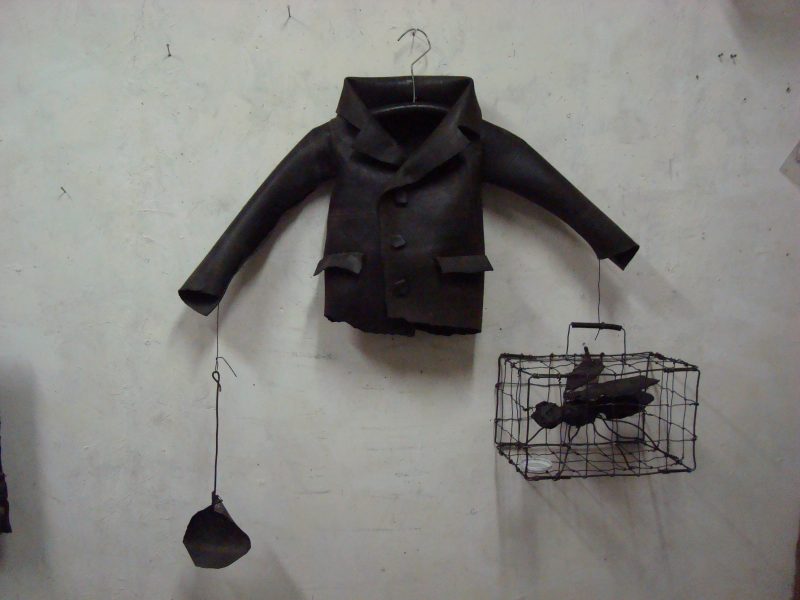Vladimir Kozin. Slavic Baroque
Curator: Janno Bergman

Two artists from St Petersburg – Vladimir Kozin and Shishkin-Hokusai are completing the 2017 exhibition programme at the Art Hall galleries. They bring with them a “delicate set of seemingly contradictory features: on the one hand, sharply ironic social criticism, and on the other, a poetic-romantic cognizance of the world,” as curator Janno Bergmann characterises the exhibition.
Vladimir Kozin graduated from the Department of Architecture and Decorative Plastic Art at Leningrad’s Vera Mukhina Higher School of Art and Design in 1980. Kozin has done praiseworthy work in organising and implementing new initiatives. With his participation, and often at his initiative, several art groups and galleries have been born. In 1996, Kozin was one of the main organisers of the New Blockheads´ Brotherhood. Together with the other members, more than 70 performances, exhibitions in gallery corridors and toilets, as well as joint readings and seminars have been organised. “Humility amplified to idiocy and poverty exalted as philanthropy were the aesthetic tools of the New Blockheads,” Anna Matvejeva, who was a member of the group, has written. “By refusing to exchange art for money and document the art process on principle, the Blockheads became a legend,” says Pyotr Belyi, whose activities from 2012 to 2016 again shed light on the group. Smaller retrospectives in Moscow and St Petersburg were followed by a large survey exhibition at the Moscow Museum of Modern Art in 2016. After the group faded away, a new mobile gallery called PARAZIT was started at the initiative of Vladimir Kozin. Kozin is the director of the alternative contemporary art museum called the Contemporary Art Mousetrap and the founder of the smallest 10×15 Gallery in St Petersburg. He is a member of the St Petersburg Free Culture humanitarian fund.
Vladimir Kozin’s oeuvre has used extremely diverse means of expression. He cultivates the genres of sculpture, installation, performance, photo, video and author’s books. As the creator of sculptural objects and series, he’s expressively playful and provocative in his monumental allegorical installations. Kozin’s work called Closer to the Flesh, which depicted lice, bedbugs and fleas made of rubber that have been enlarged 500 to 5,000 times was a Kandinsky Prize nominee in 2009. The artist had the following to say about it, “I believe that the age of the New Matriarchy is coming. And with it, a New Corporeality. Therefore, I am unleashing my heavy artillery – bugs and parasites – God’s perfect little beasts – and sending them on a search for new flesh.” Speaking about the exhibition at the City Gallery, he is not kidding when he says, “One part of my exhibition is called “Eternal Values” and it deals with themes, questions and problems that have been presented in various eras and societies … The answers to these questions are difficult to arrive at, because, as we know, history as a rule does not teach us anything.” And yet, the artist continues the dialogue fed by a worrying absurdity with the art history and the context of the current art world. The installation called Everyone Will be taken into the Future, which is included in his Slavic Baroque exhibition, revives Vasily Vereshchagin painting from 1871 called The Apotheosis of War, alludes to Marina Abramović’s 1997 installation and performance called Balkan Baroque, and disputes the 30-year-old statement by Ilya Kabakov that “not everyone will be taken into the future”. All that’s left is to delve into the future scenario provided by Vladimir Kozin, which, as already mentioned, is far from being funny.
The curator of the Second Life and Russian Baroque exhibition is Janno Bergmann (b. 1975), who is known as an artist and promoter of artistic relations between St. Petersburg and Pärnu County. Last year, he also curated a selection of St Petersburg contemporary visual art at the Tartu Art House. The creatively active Bergmann has graduated the Sütevaka Secondary School, Academy Non Grata and Academy Grata that are of noteworthy importance on the Estonian art scene.
We would like to thank: Estonian Cultural Endowment, Estonian Ministry of Culture, Tallinn Department of Culture, Veinisõber, Kuu Stuudio and Sadolin.


